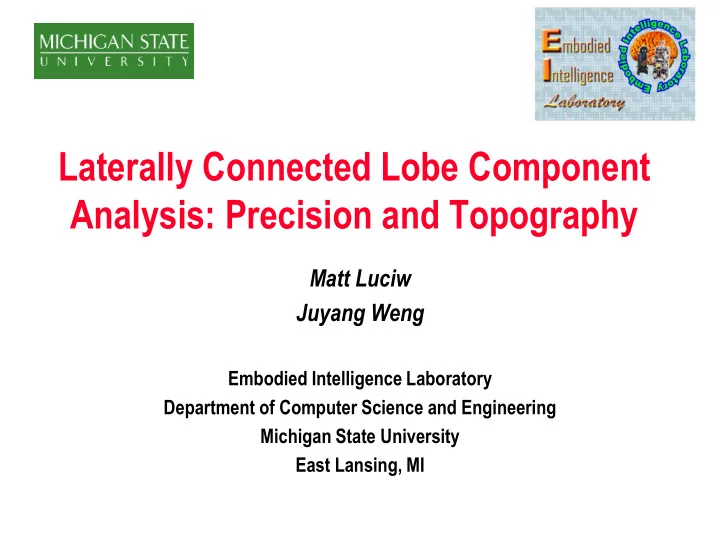

Laterally Connected Lobe Component Analysis: Precision and Topography Matt Luciw Juyang Weng Embodied Intelligence Laboratory Department of Computer Science and Engineering Michigan State University East Lansing, MI
Enabling Emergent Internal Representation • Internal representation for non-symbolic agents • Emergent : develops from experience • Efficient : utilize limited resource • Effective : leads to good performance • How must learning mechanisms adapt throughout the time course of development?
Cortex-Inspired Multilayer Two-Way Networks • Level of modeling Adapted from Kandel, Schwartz and Jessell 2000 • Firing rate model • Explicitly weighted connected neurons • Hebbian learning (LCA) • Pathway development • Hierarchical, layered networks from sensors to motors • Sensors: pixels from camera • Motors control actions and behavior Visuomotor pathways in cortex • Three types of connections 1. Bottom-up 2. Top-down 3. Lateral
Context of This Work Optimal synaptic weight learning: LCA (Weng and Zhang, WCCI 2006, Weng and Luciw, TAMD) Top-down connections Class-based grouping (Luciw and Weng, WCCI 2008) Top-down connections and Time Almost-perfect recognition in centered objects (Luciw and Weng, ICDL 2008) This work: Extend LCA and MILN with adaptive lateral excitatory connections Michigan State University 4
Related Work: Lateral Connections SOM (Kohonen) Isotropic updating Scope and learning rates manually tuned LISSOM (Miikulainen et al.) Explicit lateral excitatory and inhibitory connections Learning rates manually tuned MILN (Weng et al.) ``Growing cortex’’ (scheduled growth times) Optimal LCA: Automatic tuning of learning rates LC-LCA within MILN (this work) Explicit lateral excitatory connections Using optimal LCA framework Including top-down connections Michigan State University 5
Motor and Somatosensory Organization • Primary cortical areas are organized topographically. Michigan State University 6
FFA and PPA Areas Tootell, et al. fMRI mapping of a morphed continuum of 3D shapes within inferior temporal cortex, 2007
V1 Connectivity Buzas, et al. Model-based analysis of excitatory lateral connections in visual cortex, 2006
Lateral Excitation: Conflicting Criteria Early stages: the brain must organize more globally Critical for generalization with limited connections Mechanism: Isotropic updating Later stages: the brain must fine-tune its representation Critical for superior performance Lateral excitation mechanisms for both? Isotropic updating: organized but not precise Neurons do not excite (interfere with) one another: precise but not organized Solution: adaptive lateral connections Figure from Weng, Luwang, Lu and Xue, 2007
LC-LCA Algorithm
Network Computation 1. Neurons Compute:
Lateral Inhibition 2. Neurons Compete: 1. Rank neuron pre-responses 2. Top- k are scaled and will update 3. Others do not fire • Efficient approximation: replaces iterations • Simplifies lateral dynamics, but not biologically plausible • Sparse coding emerges
LCA Updating 3. Optimal Hebbian Learning • Optimal adaptation of winners Hebbian adaptation, given stimulus (pre-synaptic activity), and firing (post-synaptic activity) Learning rates are automatically tuned Each converges to the principal component of its observations Minimize representational error in a mean-square sense
LCA Weight Development Neurons weight are roughly the expectation of their response-weighted input For lateral weights: i j Neuron i fires Michigan State University 14
Previous Method: 3 x 3 Updating Some neurons converge to specialize in low- probability parts of the input space Michigan State University 15
Effect of Adaptive Lateral Connections: Intuitive (?) Example No lateral excitation: unbalanced Isotropic updating: balanced but wasteful Adaptive Michigan State University 16
Relative Levels of Modeling Bottom-up Connections (+): level l Top-down Connections (+): level l Lateral Connections (-): higher than l Before: Lateral Connections (+): higher than l Now: Lateral Connections (+): level l Michigan State University 17
Experiments MSU 25-Objects Dataset: 25 Classes 200 images per class: 3D rotation 4/5 training data, 1/5 testing data Grayscale
Network Setup Imposed (Left): Training (Learning) (Below): Testing Communication of top firing
Experiment Setup • 5 trials for each test • Each trial trained for 25,000 image/label pairs • Error: disjoint testing samples Developmental Scheduling No adaptation of lateral weights for 500 t Schedule the number of winners (K) Compared: 3x3 with top-down 3x3 without top-down LC-LCA with top-down LC-LCA without top-down
Results: Recognition Rate
Results: Neuronal Entropy • If entropy is zero, neuron i fires for samples from a single class.
Topographic Organization Comparison
Comparison of Updating Methods LCA: SOM: LISSOM: Michigan State University 24
Results: Comparison of Updating Methods Michigan State University 25
Conclusion Laterally Connected Lobe Component Analysis Smoothness and Precision are conflicting criteria Mitigate through adaptive lateral connections Developmental scheduling Integrated networks with bottom-up, lateral, and top-down connections LCA’s optimal update leads to more stable performance Future directions Locally connected laterally connected networks Adaptive lateral connections in what/where networks Michigan State University 26
Michigan State University 27
Recommend
More recommend